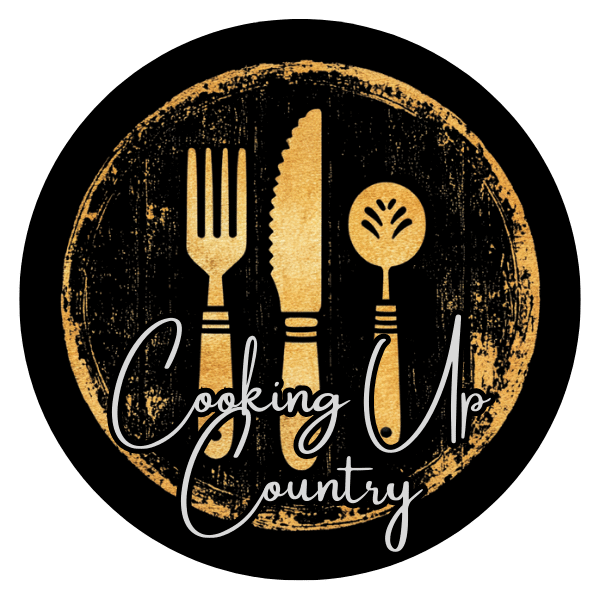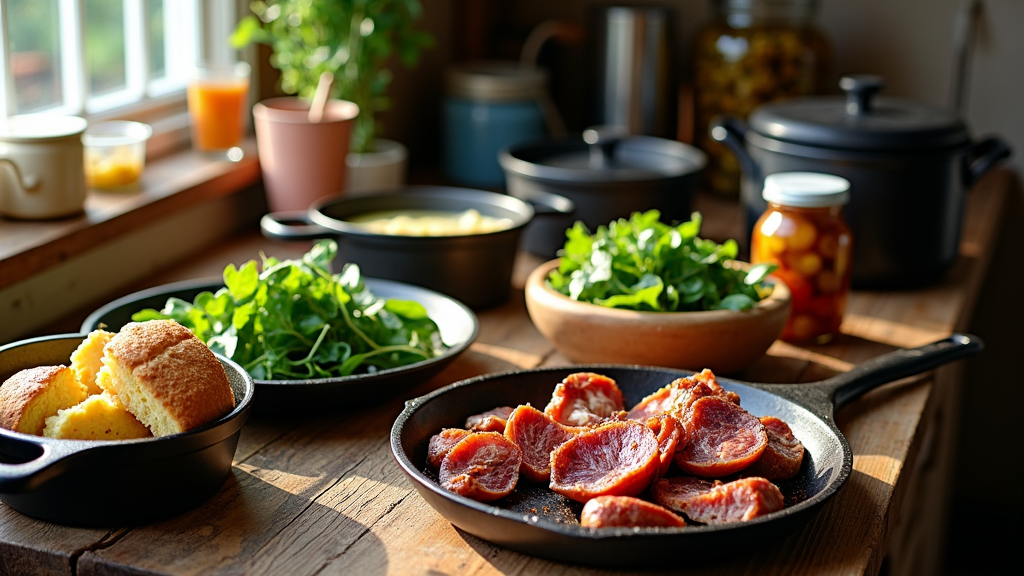Southern cooking is packed with history, tradition, and stories of survival. I’ve always found it fascinating how much of that history comes straight from what people ate, especially during hard times like the Civil War. Food wasn’t just about filling a plate or a stomach. It played a major role in culture, family, and survival. When I look at how simple army rations like hardtack turned into the soulful, comforting food we know today, I see a story of creativity and resourcefulness that still influences Southern tables.

What Shaped Southern Cooking?
The roots of Southern food run deep, blending influence from Native American, West African, and European traditions. Native Americans first introduced corn, beans, squash, and local wild game, sparking the earliest forms of Southern staples. African traditions brought rice growing, frying techniques, okra, blackeyed peas, and heavy seasoning. I always notice the strong presence of spices in slow-cooked greens in Southern kitchens, a clear example of this heritage. European settlers, especially those from Britain and France, added wheat breads, pork, and dairy practices to the mix.
Economic and social struggles after the Civil War forced people to make the most out of cheap or foraged foods. Cornbread, stews from lesser cuts of meat, and preserved vegetables all became household favorites. Whenever I see a plate of greens or fresh cornbread, I’m reminded how Southern cooking is really about adaptability and bringing people together, even when times are tough. Over time, these circumstances created a resourceful mindset in cooks and home bakers across the South, sparking new combinations and variations that we still see today.
How the Civil War Changed the Southern Table
Life during the Civil War meant ingredients were scarce. Hardtack, a basic cracker made from flour and water, became an everyday meal for soldiers. People on the home front traded or grew their own food, relying on whatever they could get. Pork, cornmeal, beans, and wild greens made frequent appearances because they were easy to store, grow, or hunt.
These limited ingredients forced cooks to get creative. I think the best examples of this came from dishes like hoppin’ John, a mix of blackeyed peas and rice, or chowchow, a pickled relish that used up leftover vegetables. Dried beans and salt pork could stretch a stew to feed a big family or a group of soldiers. Many Southern recipes come straight from this need to stretch supplies while keeping meals tasty and filling.
Sometimes, families shared what little they had with their neighbors. Seasonal gatherings allowed communities to pool resources, sharing pickled produce, pie, and hearty stews. Even children played a part, helping to collect wild greens, mushrooms, or berries from the woods. The communal spirit that developed during this era shaped not only the food, but the sense of togetherness central to Southern culture.
Soul Food’s Deep Roots in History
When I think about soul food, I see more than a meal. I see a celebration of resilience and heritage. Soul food developed mainly in African American communities during and after slavery. Enslaved people created nourishing meals from little more than cornmeal, greens, and scraps of pork given to them. Over time, these dishes—collard greens, fried chicken, cornbread, sweet potatoes, and field peas—became family favorites.
Even after emancipation, economic hardships meant many Black families continued to rely on the rich, flavorful food they had perfected out of necessity. The spice and seasoning that mark soul food come directly from West African cooking traditions, and the heavy use of greens or beans ties soul food back to the earliest Southern cook fires. This connection is what makes soul food both an expression of culture and a record of perseverance. Soul food shines a light on how generations found comfort and pride in meals crafted from what was on hand. It’s not just food; it’s culture, memory, and identity. More about the history of soul food can be found at Britannica: Soul Food.
The Real Story Behind Southern Comfort Food
Whenever someone talks about comfort food in the South, I immediately think of chicken and dumplings, slow cooked barbecue, and rich desserts like peach cobbler. Many of these dishes are rooted in times of hardship where cooks had to turn simple, inexpensive ingredients into meals that felt special. “Comfort food” just meant anything that brought warmth and a sense of home, even if it started as humble fare in an iron pot.
The origin of Southern comfort food reaches back to communal meals after church, big family gatherings, or neighborhood picnics. These get-togethers helped keep spirits up during tough times, especially in the aftermath of war or economic struggle. I often see how Southern families took the basics—beans, pork, wild greens, cornbread—and made them into dishes packed with flavor. This tradition carries through today, with these foods turning up on dinner tables across the country. Even in modern kitchens, the same recipes offer both nostalgia and celebration.
Classic Dishes, From Hardtack to Modern Plates
A lot of the most beloved Southern recipes have a direct line back to Civil War era origins. Hardtack itself may not sound appealing, but it inspired the South’s love of breads like biscuits, hoecakes, and cornbread. Salt pork used to be a necessity for military rations, but now it shows up in beans, greens, and gravies.
- Cornbread: Native American corn grinding and baking traditions met the Civil War’s need for sturdy, simple food. This marriage created a dish I see at nearly every Southern meal.
- Greens and Pork: Army cooks relied on wild greens and salted meats. These became everyday comfort food across generations.
- Fried Chicken: Often linked to celebrations, the frying technique has roots in both African and Scottish kitchens. It’s a great example of the adaptation and blended history of the South.
- Soul Food Staples: Blackeyed peas, okra, rice, and sweet potatoes stayed important thanks to how easy they were to grow and store through hard times.
The glow-up continued as Southern families gained better access to fresh ingredients, but the creative spirit behind each recipe stayed. Even today, I cook with basic staples and feel connected to cooks who needed every meal to count. Dishes that started as ways to get by eventually became icons of Southern cuisine, now served in restaurants or at big family events, cherished by all generations.
Smart Strategies That Defined Southern Cooking
Resourcefulness shaped every part of Southern cooking. After the Civil War, money and supplies were tight. Families grew gardens, raised pigs and chickens, and preserved as much as possible. Pickling, canning, and drying fruits and vegetables helped people survive winters or scarcities.
Stretching ingredients was key. For example, turning stale bread into bread pudding or biscuits, adding rice or cornmeal to stews, or bulking out greens with bacon fat. The South’s famous casseroles and gumbos came directly from these situations. When I cook today, using leftovers or inventing a new mix always strikes me as part of that long Southern tradition of making food go further. Today, new twists on classic recipes are common, but the drive to avoid waste and make every ingredient count is a tradition that remains as strong as ever.
In rural communities, “making do” was part of daily life. People shared tips on swapping ingredients, substituting what was available, and cooking for a crowd with what little they had. Community cookbooks begin to appear in the late 1800s, spreading these smart kitchen strategies and tips across larger distances, and bringing together many voices to shape what we call Southern food today.
Typical Challenges in Southern Cooking’s History
Cooking in the South meant dealing with lots of challenges. Scarcity of certain ingredients, makeshift kitchens, and unpredictable weather made meal prep tough. Here are a few hurdles cooks faced, and how they managed:
- Scarce Staples: When wheat or sugar was hard to get, corn became the main grain. Sorghum and molasses replaced white sugar in baking and sauces.
- Canning and Preserving: Glass jars and smokehouses let families keep fruits, vegetables, and meats through lean months.
- Cooking Over Fire: Most meals came together over open flames or hot coals, so soups, breads, and slow cooked stews became the norm.
- Adapting to New Crops: Leaders in the kitchen figured out ways to use invasive or newly introduced foods, such as kudzu greens or peanuts, making the best out of changing landscapes.
Learning about these strategies makes me appreciate the simple meals on my own table and understand why Southern cooking means so much to so many people. It’s a reminder of how communities look out for one another in tough times, and how innovation often comes from necessity. More details about food and the Civil War can be found at American Battlefield Trust: Civil War Cooking.
Frequently Asked Questions
Some questions come up a lot when checking out Southern cooking’s history and legacy:
What influenced Southern cooking?
Southern cooking was shaped mainly by Native American crops and techniques, West African flavors and methods, and European traditions. The climate and available resources played a big role, too, in what ended up on Southern tables.
How did food impact the Civil War?
Food had a major impact on troop morale, survival, and even the length and outcome of campaigns. Both shortages and clever substitutes led to new cooking styles. After the war, these smart changes stuck around, shaping what was served at family meals for generations.
What is the history of Southern soul food?
Soul food comes mostly from African American kitchens. It all started with cooks turning humble, available ingredients into flavorful, hearty dishes—many of them drawing from African and Southern techniques. Over time, soul food became a symbol of culture, resilience, and family gatherings.
What is the origin of Southern comfort food?
Comfort food in the South grew out of necessity. Families cooked with the simplest ingredients—ones that were homegrown or easy to store. Over decades, those foods became favorites for family gatherings and holidays, growing into a tradition of hearty, flavorful, shareable meals.
The Ongoing Legacy of Civil War Cooking
Southern cooking continues to change, but the legacy of Civil War times lives on in kitchens across the South. Even as new flavors and influences arrive, I see deep respect for resourceful recipes, slow cooking, and the sense of comfort that comes with sharing a simple meal. Every time I slice into cornbread or taste a pot of greens simmered with bacon, I’m reminded how closely food and history are linked. Each meal tells the story of the South’s creativity and strength, and every bite connects me to generations before. Bottom line, the story of Southern food is an adventure that’s still unfolding—with every dish, we keep history alive and delicious.


